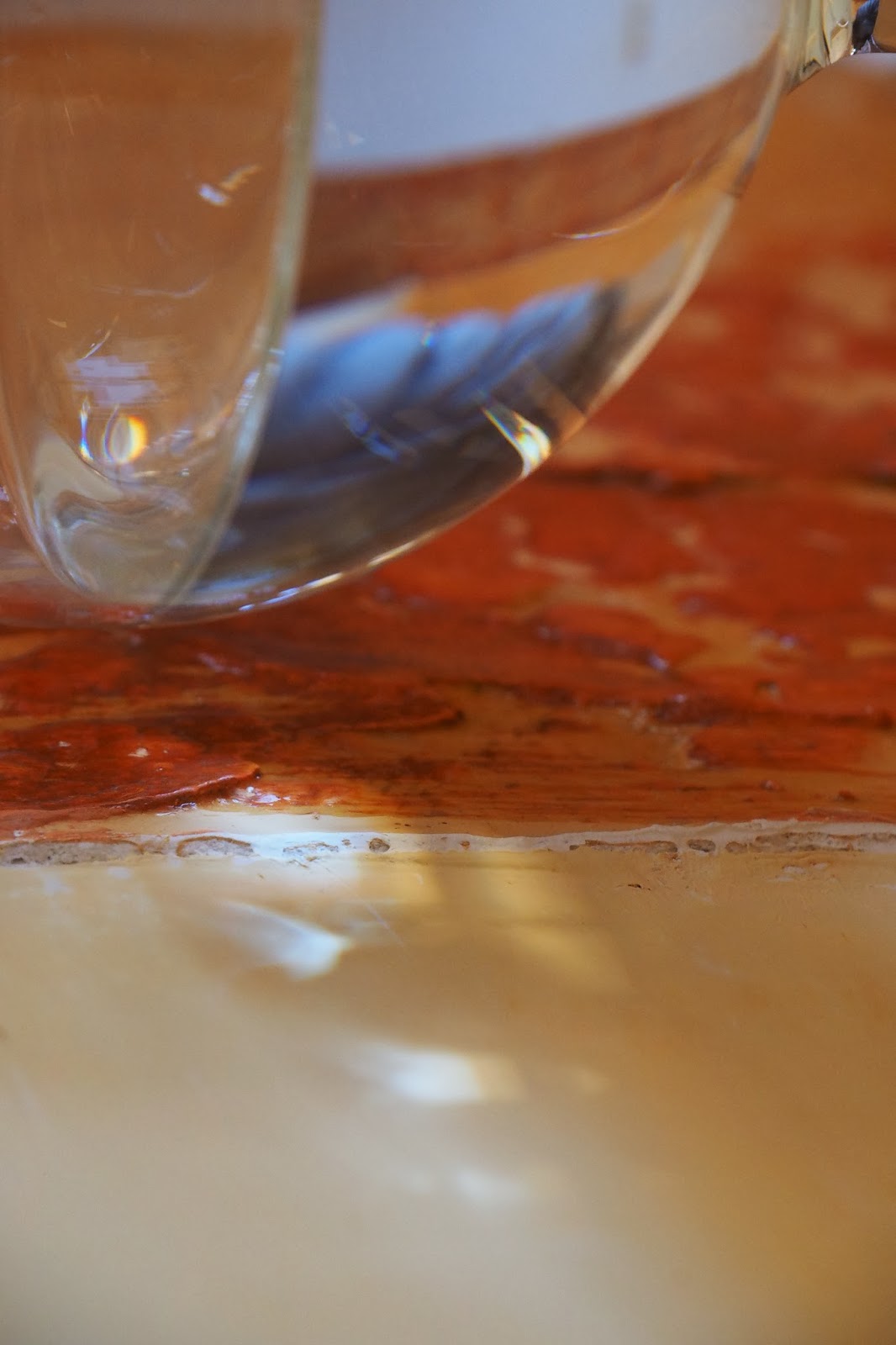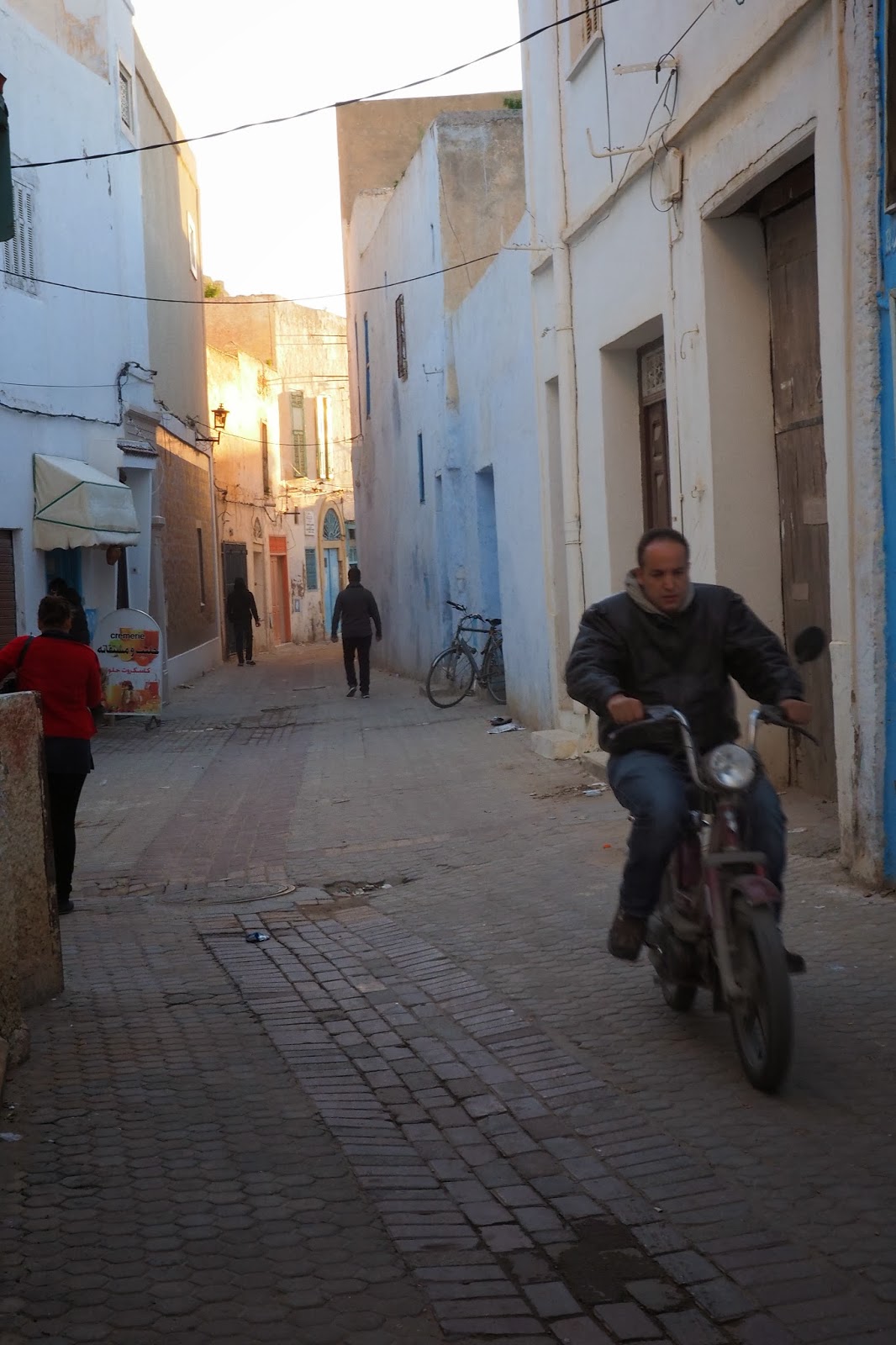Cont'd
After our buffet breakfast of bread, croissant, fruit juice, hams, sausages, yogarts, cheeses and tea or coffee, we were off again to another historic city, Kairouan (irwan or al-Qayrawan), capital of the Kairouan Governorate and its cultural capital, It's a city founded by the Arabs around 670 CE during the reign of Caliph Mu'awiya (who was caliph 661-680 CE ). It's a UNESCO World Heritage site. It's famous because of its great mosque Sidi-Uqba which became an important centre for Islamic and Quranic learning and ranks only next to Mecca and Medina in Islamic culture.
and countryside
with rows and rows of olive trees.
The restaurant where we stopped by for our lunch
There was very little we could do whilst waiting for our dishes to arrive because like many Islamic and Mediterranean culture, time is not a terribly important concern to them, unlike in the huge metropolis of capitalist Western Europe and North America. To the Muslims, the most important thing on earth doesn't happen here but in the next world, their union with the Abrahamic God whom they call Allah.
So I continued to play with my camera.
My entrée: fried omelette with seafood stuffing. Delicious!
My main course: chicken and potatoes done two ways: boiled and fried.
The outside of the restaurant from the inside
The real outside outside
The Arabs are great artists in exploiting the effect of light
A sculpture in the courtyard of the restaurant: a sword wielding Berber fighter on horseback
A Roman soldier?
How could there be soldiers without women?
The pedestal for her sculpture: it seems that Arabs abhor straight lines
We are approaching Kairouan
Paintings on the wall of a school (?) we passed

a colorful restaurant called simply "Resto"
our hotel walls
Entrance to our hotel
The main lobby
The lobby lounge
One of the restaurants
Another restaurant
The courtyard outside the hotel lobby
I got a room with a view
and a painting
As everywhere in southern Tunisia, you find horse drawn carts even on some roads in town.
The immediate vicinity of our hotel
Not 5 minutes away was the old town of Kairouan surrounded by remparts, built in the 7th century. This is a plumber shop quite close to the entry into the old city.
The streets of the 7-hectare Medina of Kairouan, is another UNESCO heritage site.
trestles in the sun on a roadside work bench
Some houses have really nice doors and metal window grilles
Some shops and stalls in the old town whose grounds are mostly inlaid with granite slabs
A cooked food stall
These are probably fried fish with all kinds of sauces and lemon to suit different palates and pancake-like bread.
An old gentleman enjoying a cigarette in front of his grocery shop
Two men chatting in front of their general store
Tunisian sweets
All kinds of sieves and baskets, big and small,colorful or plain for sale
Colorful Sieves
The famous sponge for sale: these have already been bleached
All kinds of grains and spices in no nonsense plastic tubs
freshly baked bread for sale on metal trays
An arched entrance into another part of the old town
Horse shoe arch metallic door with studs popular in Tunisia
More beans and spices for sale
Tunisian samosas
The equivalent of the Chinese "butterfly pastry": probably both learned it from the Arabs.
This is the makroud for which Kairouan is famous. It's very popular in Tunisia, Algeria and parts of Libya. Its dough is not made with flour but with semolina and it's usually stuffed with either dates or almonds and can be oil-fried, baked in a pan or an oven,
These are probably stuffed with dates.
Cones, rather like those we find in some Hong Kong cake shops

Cheaper cakes with black stuffings: dates?

Cheaper cakes with black stuffings: dates?
more expensive cakes with lighter color stuffings": almonds"

Another candy store
All freshly made
A mobile cart selling simple bread
Another roadside store selling a stuffed bun
I
got one and ate it on the roadside. Cheap but delicious. Whilst
nibbling at it, some curious school girls in uniforms after class found
it so amusing that they asked that I stand in the midst of their mobile
phone photos. Heaven knows how many of her friends have since looked at
them.
A mobile pan cake stall: cheese, sardines, sausages or cheese

roasted nuts
Another fast food bun stall
Breadsticks
Another general household goods store
Cheap Tunisian ladies fashion for the ordinary folks
Another store selling ladies clothes
carpet and toy shop
A roadside stall for colorful pottery and tiles
This one specializes on all kinds of cheese
Two old men playing cards on a make-shift table with a young man watching
There's a palm tree right in the middle of the street
And believe it or not, even a camel!
a dark passage through one of the archways
locals on mobylettes and bicycles in the streets of the old town
carpets for sale
Plastic chairs for sale. Made in China?
A Tunisian woman in the old town: they don't have to cover their faces as in some other
Muslim country
The gates on the other side of the Medina
Strings of big fat dates
Another fast food shop, plenty of customers
Miscellaneous toys and souvenirs for sale
The ubiquitous mobile phone
The sun is about to set
The mosque close to our hotel
Sidi Bousaid type windows
Party masks for sale
The other city gates
Buns for sale. No, I'm not one for photos!
Another roadside food stall: Tunisians certain like to eat.
One of the city gates: Tunisian girls are usually quite slim. They put on weight only after marriage.
bananas, my favourite!
And other fruits too
Outside the Arab museum
One of the quieter side streets: also paved with granite blocks
Entrance to a mosque

Some details of the sculpted façade (from the internet)
The same kind of trellised windows I found in Sidi Bou Said
Some houses are built over the arches with a terrace fenced in with beautiful metal grilles

with Andalucian type street lamps on the walls
blue wooden doors inside simple marble frame
The streets are quite narrow: barely 6 feet wide
The kids love photos: two kids being shown their picture by a German tourist
Another door I came across: combination of Greek, French and Turkish design
There are mosaic patterns on the ground
Houses in blue and white
Some streets are wider than others: again with ground mosaics
A Greek column at the street column
New houses built over older ones
I was brought by a friendly Tunisian to visit the shop owned by her young daughter doing handloom carpets. He offered to show me the old fountains in the old town but I hadn't have time. So I declined his offer.
Another side street
I passed another long archway, its wall being used for shoes display
A pyramid of ready-to-bake dessert
A beautiful Tunisian boy: his hair soft as silk
Back into the main street
A young man enjoying a water-filtered smoke
Two men chatting over a glass of mint tea and a cup of coffee
Sausages sizzling over a charcoal fire grill
upon closer inspection, not just sausages, portion of an egg plant too
Smoke from the sweet smelling incense wood
The archway leading back to the exit on the city wall back to our hotel
A pottery stall just outside our hotel
Reflections upon a puddle
From puddle to pool: this is one of the two surviving open air reservoirs ordered to be built between 734 and 741 CE by the governor of Kairoun, the Aghablid under the orders of the Caliph of Damascus to supply the city with drinking water. Originally, there were 15 of the. They are magnificent examples of the the kind of hydraulic installations during the Middle ages. They cover an area of 11.000m2 and had a capacity of 53.000m3. In the middle of the large circular basin where the reservoirs were built, there was an octagonal tower where the Emir came to rest.Today, the complex, recently enriched with new installations excavated during terracing work, has been turned into a park with facilities for visitors. This is where we were taken to see the next morning.
To be cont'd






























































































































沒有留言:
張貼留言